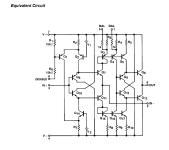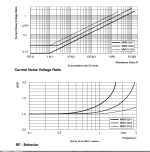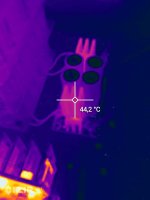and that's what I ordered, thank you 😉Mouser currently has the IXTP08N50D2 so you can feel free to use it
I would like to ask how critical the value of resistors R409/R410 is? In the diagram we have 475R, in the BOM 499R. I have already bought a 475R, but I wonder if this difference is very important.
What about AD8009?
Higher current, higher slew rate, higher bandwidth and some other pretty impressive specs (for ex. bandwith still higher with gain of 10 than what AD811 can even do with gain of 2), both are current feedback.
SOIC-8 but can be easily adapted to DIP8 with adapter (though probably not achieving 1ghz anymore, though that is just overkill for audio use anyway) or soldered on.
I mean if we're taking AD811 for I/V, might as well bring it to its logical conclusion?
View attachment 1241643
LM7171 might be another to check out
Is the AD8011 disqualified ?
It's not critical, 475R is fine 😉 .I would like to ask how critical the value of resistors R409/R410 is? In the diagram we have 475R, in the BOM 499R. I have already bought a 475R, but I wonder if this difference is very important.
Maybe I'll open a new topic about this and maybe it'll all stay here, it's about my testing of SMD tantalum resistors in all positions in the audio system. It all started with replacing the RN60 in the AD811 I/V stage.
So far I've tested tantalum resistors in;
In the amplifier and I/V stage, all resistors were replaced with new PCBs, and in the regulator only in important places, the op amp inputs and low-noise references.
Each of these changes had an impact on the sound, regardless of whether it was just a change in the resistors at the input of the op amps or the entire amplifier, the effect was always the same. A completely different sound image, more open with more detail, beautiful highs, precise bass. As I wrote somewhere before, it's like you've lifted the curtain from the speakers, a whole new world of sound. My friend started conducting similar tests with the same results, which only confirms my observations.
The only downside to tantalum resistors is the poor offer at Mouser and the price, of course SMD will be an obstacle for some.
So far I've tested tantalum resistors in;
- I/V with AD811
- amplifier 'ceci est un Cube'
- shunt regulators (for the analog and digital sections of my DAC)
- series regulators (high current version for 'ceci est un Cube')
- and I'm in the process of making a completely new Hiraga Le Monstre from zero in which all resistors including those in the regulators will be tantalum
In the amplifier and I/V stage, all resistors were replaced with new PCBs, and in the regulator only in important places, the op amp inputs and low-noise references.
Each of these changes had an impact on the sound, regardless of whether it was just a change in the resistors at the input of the op amps or the entire amplifier, the effect was always the same. A completely different sound image, more open with more detail, beautiful highs, precise bass. As I wrote somewhere before, it's like you've lifted the curtain from the speakers, a whole new world of sound. My friend started conducting similar tests with the same results, which only confirms my observations.
The only downside to tantalum resistors is the poor offer at Mouser and the price, of course SMD will be an obstacle for some.
From what i can tell i dont see why it would be as long as you observe maximum +-5V rails.Is the AD8011 disqualified ?
Whether it will be stable, or better at all than AD811 is an open question that will require to try it, depends on many factors including particular implementation of PCB, what load you are driving (cable capacitance and so on).
I wouldn't just plug it in and start listening right away (though i would expect it should be fine), you would really have to test it. With that in mind sure i encourage you to try.
I made my PCB's and got some AD8007 and AD8009 and some (likely fake) AD811's from a couple of sources just to see if i luck out. Just being lazy to actually go ahead and test everything as its time consuming. But i will post some measurements here when i do.
Btw i am sure you know this but just in case i will say AD8011 and AD811 are completely unrelated.
AD8011 seems to be one of the early ones from the XFCB fabrication process, so its more like a grandpa to AD8009, slower (though still extremely fast) and with a fifth of the output current, among other differences.
This is an interesting topic i encourage you to make a thread so it gets the attention and doesnt get buried here, and it obviously applies much wider than just our brave little AD811. Those TaN resistors are very good. I experimented with buying Manganin wire and winding my own resistors (ayrton-perry) exactly for I/V and critical positions. But they just ended up bulkier and thus less practical than i'd like.Maybe I'll open a new topic about this and maybe it'll all stay here, it's about my testing of SMD tantalum resistors in all positions in the audio system.
Isabellenhütte sells also some zeranin and manganin resistors, but mostly in shunt values (<1R).
But it came in handy for example when building MyRef amp which has a critical shunt in feedback path.
Btw, i am curious but i wouldn't be surprised if part of the improvement is just in it being SMD. Even if its not popular for DIYers SMD has massively smaller parasitics. But RN60 is already a high bar so maybe not.
Also, another interesting fact is that Isabellenhütte for some reason is also on LCSC.
The 8011 according TI papers is 50 ohms input (inverting), so more than AD811. But I also understand it heats way less and is more recent, so better process. TI highligthed the AD8011 as their sota CFA op.
I don't find informations about its noise in the audio band and the one of the AD811; both having anyway too much strong noise here buut of course very low noise at high frequencies.
For me its slew rate, bandwidth, is more than enough for our needs. Too much is not a gift hatever the care on the pcb side.
I am curious to benchmark it vs the AD9631. But if the 811 is better,, it is time and monney lost indeed.
I am not sure whatever Ayrton Perry style, wirewound resistor should be chosen with such high speed op amps ? It's HF territory here !
I don't find informations about its noise in the audio band and the one of the AD811; both having anyway too much strong noise here buut of course very low noise at high frequencies.
For me its slew rate, bandwidth, is more than enough for our needs. Too much is not a gift hatever the care on the pcb side.
I am curious to benchmark it vs the AD9631. But if the 811 is better,, it is time and monney lost indeed.
I am not sure whatever Ayrton Perry style, wirewound resistor should be chosen with such high speed op amps ? It's HF territory here !
But RN60 is already a high bar so maybe not.
Weird, cannot stand these.
Maybe some discrete design as CFA?
Simplified schematic is in EL2020 datasheet.
Also different (but same concept) are present in other Application notes...
(I also tried EL2020 OP as IV was maybe a bit better than AD811?)
Simplified schematic is in EL2020 datasheet.
Also different (but same concept) are present in other Application notes...
(I also tried EL2020 OP as IV was maybe a bit better than AD811?)
You mean this scheme?
I have nothing against it, but from my experience, discrete I/V are quite sensitive to the choice of semiconductors, so there would be no end to the game. So why not try the upgraded version, ADEL2020?
I have nothing against it, but from my experience, discrete I/V are quite sensitive to the choice of semiconductors, so there would be no end to the game. So why not try the upgraded version, ADEL2020?
Attachments
I don't believe that the reason SMD is better is because of lower parasitics, I have replaced a lot more SMD than TH resistors. Vishay MELF are usually good in the RF range, better than RN60 for sure. Another thing that makes MELF better than classic SMD resistors is lower noise. And regardless of all that, tantalum resistor is still better than MELF. Certainly, non-inductance is also a factor, but not as much as the choice of materials and technology.This is an interesting topic i encourage you to make a thread so it gets the attention and doesnt get buried here, and it obviously applies much wider than just our brave little AD811. Those TaN resistors are very good. I experimented with buying Manganin wire and winding my own resistors (ayrton-perry) exactly for I/V and critical positions. But they just ended up bulkier and thus less practical than i'd like.
Isabellenhütte sells also some zeranin and manganin resistors, but mostly in shunt values (<1R).
But it came in handy for example when building MyRef amp which has a critical shunt in feedback path.
Btw, i am curious but i wouldn't be surprised if part of the improvement is just in it being SMD. Even if its not popular for DIYers SMD has massively smaller parasitics. But RN60 is already a high bar so maybe not.
Also, another interesting fact is that Isabellenhütte for some reason is also on LCSC.
Attachments
Will the SMD tantalums sound as good/better than the leaded Shinkoh ones? There's a guy in Hungary selling a lot of values on ebay. Not cheap and I don't know if they are original.Maybe I'll open a new topic about this and maybe it'll all stay here, it's about my testing of SMD tantalum resistors in all positions in the audio system. It all started with replacing the RN60 in the AD811 I/V stage.
I don't know, I've never used Shinkoh, this is my first encounter with tantalum resistors. In any case, these SMDs are a good bet.
Yes i bet it was state of the art in 2005, but its worse in every way to 8009, for example inverting input being only 8 ohms, even lower than AD811.The 8011 according TI papers is 50 ohms input (inverting), so more than AD811. But I also understand it heats way less and is more recent, so better process. TI highligthed the AD8011 as their sota CFA op.
I don't find informations about its noise in the audio band and the one of the AD811; both having anyway too much strong noise here buut of course very low noise at high frequencies.
For me its slew rate, bandwidth, is more than enough for our needs. Too much is not a gift hatever the care on the pcb side.
But you can try it, sure. If i am going into uncharted territory might as well take the best currently offered.
Yes all of it is extreme overkill in terms of specs. And indeed they are not like your regular OPA16xx whatevers that you would have to try hard to make oscillate, and can just roll opamps relatively carefree.
It was regarding manufacting your own resistors from thin wire of special material called manganin. Ayrton Perry is a style of winding that minimises inductance. Dont worry about it.I am not sure whatever Ayrton Perry style, wirewound resistor should be chosen with such high speed op amps ? It's HF territory here !
Besides that one should think of wirewound resistors as inductors which happen to have some resistance.
They are usually just for power resistors so not sure where you are getting them for this.
I would strictly avoid it inside a feedback loop of an opamp. Some have even managed to make tubes oscillate when putting them as cathode resistors.
Carbon-film ones have a helicoid so maybe you meant that, but they are also not the best.
Last edited:
🙂So why not try the upgraded version, ADEL2020
Yes that is new version, probably available... Maybe os worth yo try?
As I am remembering well less overhaet than AD811, can vork with higher V suplies.
Sound even a bit less "harsh" than AD811?
Maybe some discrete design as CFA?
Simplified schematic is in EL2020 datasheet.
Also different (but same concept) are present in other Application notes...
(I also tried EL2020 OP as IV was maybe a bit better than AD811?)
Hi Zoran,
many said the AD EL2020 was an hidden geme indeed.
Maybe with double package BJTs when posssible to reduce the layout and to thermal couple with paste two close sot-23 when needed.
Anyway all those op amps have global feedback still ? Perhaps the discrete adaptation could permit more freedom here ?
@Vunce , Zoran has I surmise an climbing ear in the trebles perhaps which makes him peaky at prefering some confs perhaps. He found also bad sounding the op861 which is not for I when some cares are used in the passive parts arounds. Still my ref on my TDA1541A, I find quite neutral for a NOS (maybe still that small part of lack of anti alliasing or my loudseaakers that has a 700 Hz peak). Had not time to assemble what Thorsten Loesch gave me to finish the TDA1541A new sauce. (I hibernate for the moment). Brijac should have finished his personal modular itteration we hope.
Maybe only without global FB with CF Buffers? As Current devices. Io DAC to Buffer Output, External BJT circuit for extracting Current to Riv.Anyway all those op amps have global feedback still ? Perhaps the discrete adaptation could permit more freedom here ?
Problem is they are also obsolete... LH0002, LH0064.
Maybe BUF634 and OPA633 and others are still available?
I tried AD811 with TDA1540 and TDA1541A only, Not with other DAC types 🙂AD811 I/V…. “harsh”….??
I would never describe the sound as harsh, polar opposite.
Sorry I didn't wrote this, I should, because i dont want to speak in general?
.
And It depend on speakers as contact point... If they are Higher eff. and some type of horn with directivity as the factor,
too fast op can be "harsh", in opposite to other standard OPs, and with HF filter, that can be rather "mellow" or "chewing gum"... IMHO.
Best fit are Ge or Tube design... 🙂
I have no desire to research anymore, I have my two trump cards, whether it's CFA or VFA op amps. If someone is going to invest 30 euros for two ADEL2020s and test them, go ahead.🙂
Yes that is new version, probably available... Maybe os worth yo try?
As I am remembering well less overhaet than AD811, can vork with higher V suplies.
Sound even a bit less "harsh" than AD811?
Now I've taken another thermal image of the AD811 with small BGA heatsinks, the temp doesn't exceed 44C, which isn't really overheating at +/-15V.
I wouldn't exactly say that the AD811 has a 'harsh' sound, quite the opposite as Vunce says, not even with the TDA1541 on which I also tested it about 15 years ago. If it had been 'harsh' then, I certainly wouldn't use it today or even try it again .
Attachments
- Home
- Source & Line
- Digital Line Level
- AD811 as I/V stage for current DACs (and test some other opamps including Burson Audio opamps as I/V)


